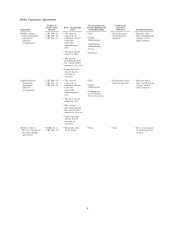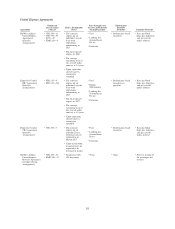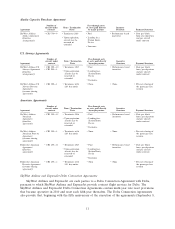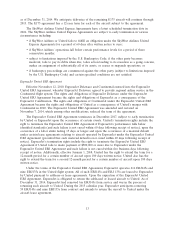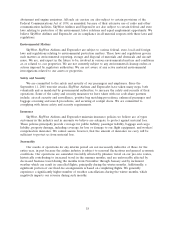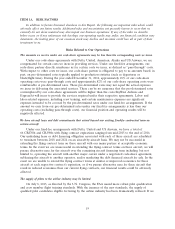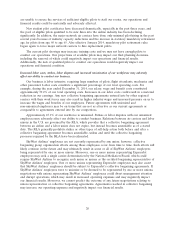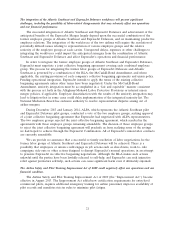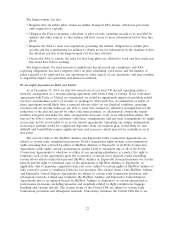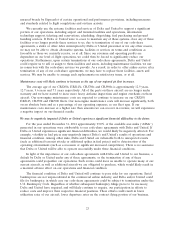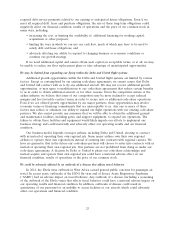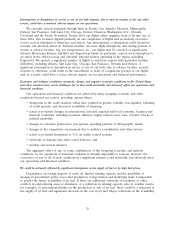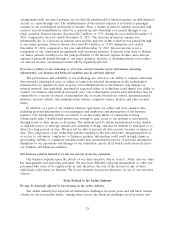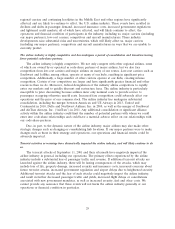SkyWest Airlines 2014 Annual Report Download - page 24
Download and view the complete annual report
Please find page 24 of the 2014 SkyWest Airlines annual report below. You can navigate through the pages in the report by either clicking on the pages listed below, or by using the keyword search tool below to find specific information within the annual report.ITEM 1A. RISK FACTORS
In addition to factors discussed elsewhere in this Report, the following are important risks which could
adversely affect our future results. Additional risks and uncertainties not presently known to us or that we
currently do not deem material may also impair our business operations. If any of the risks we describe
below occur, or if any unforeseen risk develops, our operating results may suffer, our financial condition may
deteriorate, the trading price of our common stock may decline and investors could lose all or part of their
investment in us.
Risks Related to Our Operations
The amounts we receive under our code-share agreements may be less than the corresponding costs we incur.
Under our code-share agreements with Delta, United, American, Alaska and US Airways, we are
compensated for certain costs we incur in providing services. Under our fixed-fee arrangements, our
code-share partner directly reimburses us for certain costs we incur, as defined as ‘‘pass-through’’ costs.
With respect to other costs we incur, our code-share partner is obligated to pay to us amounts based, in
part, on pre-determined rates typically applied to production statistics (such as departures or
block/flight time). During the year ended December 31, 2014, approximately 18% of our code-share
operating costs were pass-through costs and approximately 82% of our code-share operating costs were
reimbursable at pre-determined rates. These pre-determined rates may not equal the actual expenses
we incur in delivering the associated services. There can be no assurance that the pre-determined rates
contemplated by our code-share agreements will be higher than the costs SkyWest Airlines and
ExpressJet will incur to provide the services required under their respective agreements. Labor and
labor-related expenses, including crew training, and certain maintenance expenses are significant
expenses intended to be covered by the pre-determined rates under our fixed-fee arrangements. If the
amount we earn from our pre-determined rates under our fixed-fee arrangements is less than our
operating costs (excluding pass-through costs), our financial position and operating results will be
negatively affected.
We have aircraft lease and debt commitments that extend beyond our existing fixed-fee contractual term on
certain aircraft.
Under our fixed-fee arrangements with Delta, United and US Airways, we have a total of
66 CRJ700s and CRJ900s with flying contract expirations ranging from mid-2015 to the end of 2016.
Our underlying lease or debt financing obligation associated with each of these aircraft are scheduled
to terminate between 2018 and 2024 on an aircraft-by-aircraft basis. We may not be successful in
extending the flying contract term on these aircraft with our major partner at acceptable economic
terms. In the event we are unsuccessful in extending the flying contract terms on these aircraft, we will
pursue alternative uses for the aircraft over the remaining aircraft financing term including, but not
limited to, operating the aircraft with another major carrier under a negotiated code-share agreement,
subleasing the aircraft to another operator, and/or marketing the debt financed aircraft for sale. In the
event we are unable to extend the flying contract terms at similar or improved economics for these
aircraft at each respective contract’s expiration, or if we pursue alternative uses for these aircraft that
result in reduced economics than our current flying contracts, our financial results could be adversely
affected.
The supply of pilots to the airline industry may be limited.
On July 8, 2013, as directed by the U.S. Congress, the FAA issued more robust pilot qualification
and crew member flight training standards. With the issuance of the new standards, the supply of
qualified pilot candidates eligible for hiring by the airline industry has been dramatically reduced. If we
19


